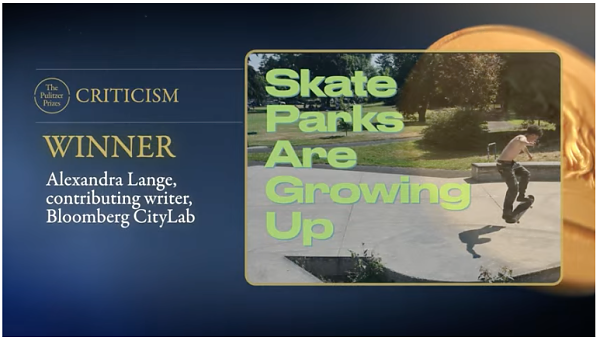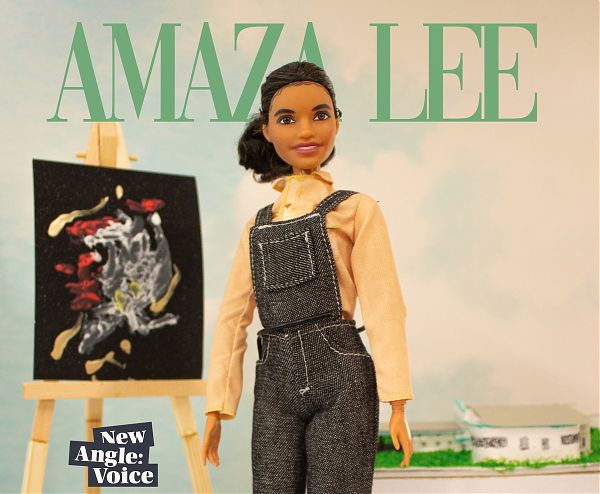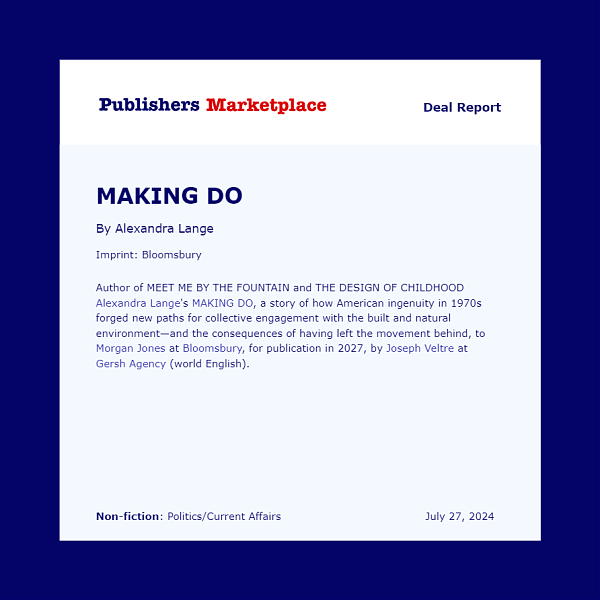Winner of the 2025 Pulitzer Prize in Criticism

For this series on designing better public space for children and families.
Thank you to the Pulitzer Prize jury for this award, and to my editors at Bloomberg CityLab, Kriston Capps, Nicole Flatow, and David Dudley, for encouraging and supporting this work. Kids deserve the best.
Beyond Architecture: The Fantasy Worlds of Phyllis Birkby

Noel Phyllis Birkby Papers, Sophia Smith Collection, Smith College
Pushed to the side and rarely credited for her architectural work at Davis Brody, Phyllis Birkby became a significant figure in extending the lesbian women’s movement to architecture during the 1970s. Her Environmental Fantasy Workshops played a crucial role in galvanizing the community, providing a creative and empowering space within a male-dominated profession.
Growing out of other consciousness raising techniques, freed up in her classes, Phyllis released the rigor of her conventional training to get down on the floor, and lead the group in sketching their fantasies — however outlandish — on giant rolls of butcher paper.
Birkby’s work not only contributed to architectural discourse but also fostered a sense of collective identity among lesbian architects, highlighting the intersectionality of gender, sexuality, and professional identity in the field. In her later years, she focused on architecture for people marginalized in other ways – by addiction, by age, and by disability, again imagining spaces of community and support.
Laying the Groundwork: Women in American Architecture

In this episode, we revisit the first significant effort to publicly tell the under-told stories of American women in architecture: “Women in American Architecture: A Historic and Contemporary Perspective.”
On view at the Brooklyn Museum from February to April of 1977, the groundbreaking exhibition and simultaneous book, curated and edited by Susana Torre, defined the state of play for women in the architecture profession.
Alienated by the profound hostility expressed by the AIA, women architects found an accepting cohort at the Architectural League of New York. We organized. We canvassed. We raised our consciousnesses. The project team identified subjects so previously obscured as to be unknown, and then with the energy and drive of a furious mob, they broke through and laid the groundwork for scholarship, social change, and recognition of women architects for the next fifty years.
Sarah Harkness and Jean Fletcher: Architecture, Family Style

Sally Harkness, Jean Fletcher, and their fellow partners in The Architects Collaborative, 1951.
The fifth and final episode of New Angle: Voice, Season 2, takes us to Six Moon Hill, a modernist cul-de-sac in Lexington, Massachusetts, where Sarah (better known as Sally) Harkness, Jean Fletcher, their husbands, and their partners at The Architects Collaborative, tried to build a suburb that could support, not isolate, working women — including themselves.
Read deeper biographies of Sarah Pillsbury Harkness and Jean Bodman Fletcher by Michael Kubo on the Pioneering Women website.
Meet Me by the Fountain in Paperback, Dec. 5

The paperback of Meet Me by the Fountain will be published on December 5! All the same content in a new, more portable package. It makes a very meta holiday gift.
I’ve been doing a bunch of publicity in support of the launch, including this story at Bloomberg CityLab, and radio interviews at Marketplace and Today, Explained.
Was also thrilled to see it on the New York Times Book Review’s recommended Paperback Row.
Remembering Jean-Louis Cohen

Disney Concert Hall tour in February 2003, I am third from the right, JLC far right. (Photo Courtesy Karen Leader)
Curator, architect and historian Jean-Louis Cohen died suddenly in August. Along with his many international accolades and accomplishments, he was also my dissertation advisor at the Institute of Fine Arts and, latterly, a friend. I contributed this short memory to a collection of memorials published in The Architect’s Newspaper.
The death of Jean-Louis Cohen has been a shock and a deep sadness. I had not seen him in person since the beginning of the pandemic, but it was one of the delights of adulthood that someone so smart, so connected, and, as a 25-year-old master’s student, so intimidating, could eventually morph from a teacher into a mentor into a friend.
I and several of my classmates in my IFA cohort are small women; when we first started at the Institute, I imagined us as ducklings following behind Jean-Louis. The dramatic West Coast version of this dynamic was captured in a Los Angeles Times article about a field trip he took us on to Los Angeles, perhaps his third beloved city after Paris and Casablanca. On that trip, our buttoned up, urbane advisor revealed himself to have a California persona—open collar, sportscar—and the rest of us, packed into minivans, could only rush across multiple lanes of traffic to catch up as we zig-zagged up and down the coast from Eames to Wright to Schindler to Gehry. I had never been to L.A. before and I still remember standing in the mirrored bathroom of John Lautner’s Sheats-Goldstein house (the original Cocaine Décor) and thinking, Where am I? Where has this been my whole life? I hadn’t even known this kind of architecture existed, and it took a middle-aged Frenchman to show it to me. Jean-Louis didn’t want us to follow—he wanted us to catch up and, thanks to his tutelage, we eventually did.
When I began the MA program at the IFA, I had already been working as a journalist for four years. My plan was to get a PhD and then use that knowledge to support my work as an architecture critic. I didn’t realize then how unusual it was within academia, and especially during that era of the Institute, to encourage public scholarship. But Jean-Louis enthusiastically supported the notion of writing for mainstream media, and demonstrated, through his own writing, curation, friendships, and choice of topics, that engaging with the broadest possible public could be the core of the intellectual project.
His own work often took a topic that had been covered a million times—postwar architecture, Le Corbusier, Frank Gehry—and demonstrated that there were plenty of new things to say if you (he) looked at it from a different angle. Even though he spoke more languages, knew more cities, and had already published more work than most of his advisees ever would, he took our interests and ideas seriously, asking questions, asking us to be more provocative, and never herding us back toward some imagined safe architecture history. A radical proposal didn’t necessarily mean going to the ends of the earth but deep into the archives, interrogating the dominant perspective, politics, or value systems. My dissertation, which he enthusiastically supported, was on the surface about postwar corporate architecture, the most heroic and bureaucratic of topics, but ended up launching my ongoing research interest in collaboration and personal networks. Classmates wrote about sculpture, vernacular architecture, technology; there was never one dominant period, geography, style, or discipline for the dissertations his students wrote. He didn’t care about that kind of limit, or reputation management, or reflection, and he empowered all of us to ignore those terms as well.
Anna Wagner Keichline: A Legacy of Invention

In the penultimate episode of New Angle: Voice, Season 2, meet Anna Wagner Keichline, architect, inventor, suffragette, and loyal daughter of Bellefonte, Pennsylvania.
Nineteen-thirteen was the year of the grand march for suffrage in Washington DC, where the 250,000 marchers and attendees eclipsed coverage the following day of the inauguration of Woodrow Wilson. Bellefonte PA, population 4,216, had its own march, on the Fourth of July. Costumes were de rigueur, with a goodly number of stately toga-clad ladies and a few wild harridans on horseback, along with one intrepid girl in her Cornell cap and gown: Anna Wagner Keichline.
Not every architect has the opportunity to build skyscrapers. In Bellefonte, Anna used her talents to improve the lives of her neighbors by designing their houses and gathering places. She adopted a gently accommodating architectural style in the shadow of all that high Victorian tracery, and designed sturdy churches, theaters, homes, schools, and recreation facilities in her hometown that still stand well and firmly in their context. But on her own time, she experimented with the latest technologies, eventually earning seven patents on inventions ranging from a fitted kitchen to a modular concrete brick.
Amaza Lee Meredith: Love and Home

In our third episode of Season 2, meet Amaza Lee Meredith: architect, entrepreneur, queer Black pioneer.
From the introduction by producer Cynthia Phifer Kracauer, who has also been making custom Barbies for each of our podcast subjects:
I picked up a free glossy real estate magazine with an enticing photograph of summer leisure pursuits under the title “Sag Harbor: A Whale of a Good Time.” We traveled out there in early spring, collecting voices of preservation, community, celebrity, and long tenured summer families as we searched for Amaza Lee Meredith’s modern architecture. A short bike ride away from the summer haunts of Melville, Steinbeck, Betty Friedan, Spalding Gray, lived the creator of Azurest North, the Black summer real estate enclave syndicated by Amaza Lee Meredith with her sister Maude Terry. But on the beach we found only Maude’s name enshrined on the commemorative plaque.
Ray Eames: Beauty in the Everyday
New Angle: Voice is back! We kick off Season Two with a profile of Ray Kaiser Eames.
Many know Ray Eames as the small, dirndled woman behind her more famous husband. In this episode, we uncover the talented artist who saw the world full of color, the industrial designer bending plywood in the spare bedroom, and the visionary who treated folk art, cigarette wrappers, flowers, and toys as equally valuable and inspiring. Ray brought the sparkle to the legendary Eames Office, as you’ll discover in this episode.
Special thanks to the people you’ll hear in this episode: Pat Kirkham, Lucia Dewey Atwood, Llisa Demetrios, Jeannine Oppewall, Donald Albrecht, Meg McAleer and Tracey Barton at the Library of Congress, and Alexandra Lange.

On X
Follow @LangeAlexandraOn Instagram
Featured articles
CityLab
New York Times
New Angle: Voice
Getting Curious with Jonathan Van Ness